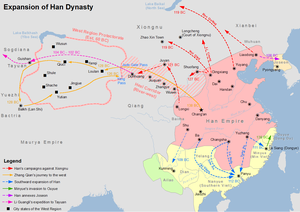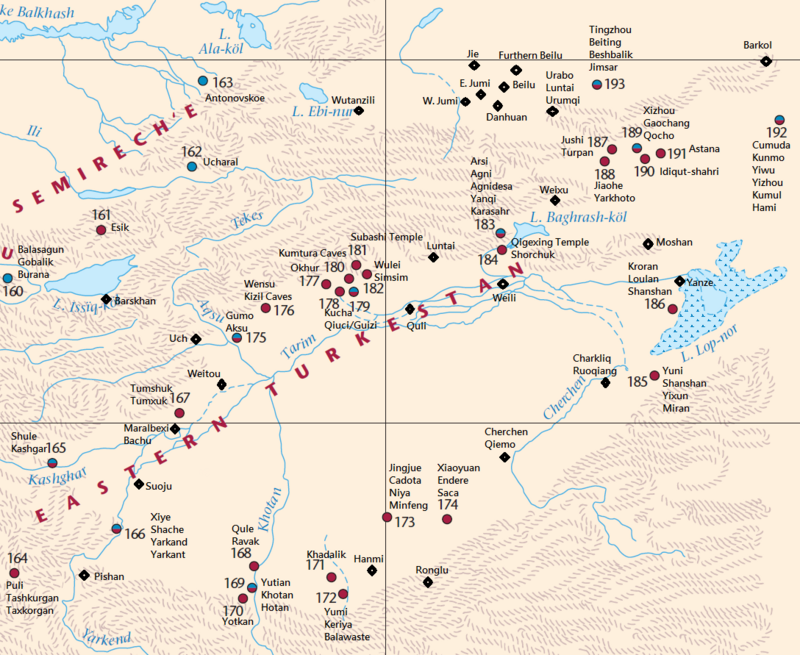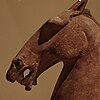Protectorate of the Western Regions

| History of Xinjiang |
|---|
 |
The Protectorate of the Western Regions (simplified Chinese: 西域都护府; traditional Chinese: 西域都護府; pinyin: Xīyù Dūhù Fǔ; Wade–Giles: Hsi1-yü4 Tu1-hu4 Fu3) was an imperial administration (a protectorate) situated in the Western Regions administered by Han dynasty China and its successors on and off from 59 or 60 BCE until the end of the Sixteen Kingdoms period in 439 AD.[1] The "Western Regions" refers to areas west of Yumen Pass, especially the Tarim Basin in southern Xinjiang. These areas would later be termed Altishahr (southern Xinjiang, excluding Dzungaria) by Turkic-speaking peoples.[2] The term "western regions" was also used by the Chinese more generally to refer to Central Asia.
The protectorate was the first direct rule by a Chinese government of the area.[2][3] It consisted of various vassal states and Han garrisons placed under the authority of a Protector-General of the Western Regions, who was appointed by the Han court.
History

Background
During the
Prior to the establishment of the protectorate, there was a preceding post known as the "Colonel [for the Assistance of Imperial] Envoys" that was established a year after the War of the Heavenly Horses ended in 101 BC. After the war, Han posts were erected between Dunhuang and the Salt Marsh with several hundred farmer soldiers stationed at Luntai and Quli. The post was established to guard their farmland and to take care of grain storage for Han envoys traveling to other states.[7]
Establishment
The position of Protector-General was officially established in 59 or 60 BCE after the
It was the highest Han dynasty military position in the west during its existence. During the peak of the Protectorate's power in 51 BCE, the Wusun nation was brought under Han submission.[3] The post was abandoned after the usurpation of Wang Mang (Xin dynasty) from 8-22 CE. By then, at least 18 different people had served as protector-general, though only 10 of them have known names. In 45 CE, the eighteen states of the Western Regions requested the re-establishment of the Protectorate to restore peace to the region, but Emperor Guangwu of Han refused.[8]
During the second half of the first century CE, at the time of the Eastern Han dynasty, Chinese armies led by
On 29 July 107, a series of Qiang uprisings in the areas of Hexi Corridor and Guanzhong. Duan Xi was killed and the post was abandoned. The Protectorate was later restored from 123-124 by the son of Ban Chao, Ban Yong. The Protectorate was again revived in 335 by Former Liang and headquartered in Gaochang until the demise of Northern Liang.[7]
In the southern Tarim Basin, coins from the period of the Protectorate's existence have been found with inscriptions in both Chinese and the
In the 7th century, a successor administration, the
Thirty-six city states

| City | Households | Population | Soldiers |
|---|---|---|---|
| Beilu | 277 | 1,387 | 422 |
| Further Beilu | 462 | 1,137 | 350 |
| Danhuan | 27 | 194 | 45 |
| Guhu | 55 | 264 | 45 |
| Gumo | 3,500 | 24,500 | 4,500 |
| Hanmi | 3,340 | 20,040 | 3,540 |
| Jie | 99 | 500 | 115 |
| Jingjue | 480 | 3,360 | 500 |
| Eastern Jumi | 191 | 1,948 | 572 |
| Western Jumi | 332 | 1,926 | 738 |
| Jushi | 700 | 6,050 | 1,865 |
| Further Jushi | 595 | 4,774 | 1,890 |
| Loulan | 1,570 | 14,100 | 2,912 |
| Moshan | 450 | 5,000 | 1,000 |
| Pishan | 500 | 3,500 | 500 |
| Pulei | 325 | 2,032 | 799 |
| Further Pulei | 100 | 1,070 | 334 |
| Qiangruo | 450, | 1,750 | 500 |
| Qiemo | 230 | 1,610 | 320 |
| Qiuci | 6,970 | 81,317 | 21,076 |
| Qule | 310 | 2,170 | 300 |
| Quli | 240 | 1,610 | 300 |
| Shule | 1,510 | 18,647 | 2,000 |
| Suoju | 2,339 | 16,373 | 3,049 |
| Weili | 1,200 | 9,600 | 2,000 |
| Weitou | 300 | 2,300 | 800 |
| Weixu | 700 | 4,900 | 2,000 |
| Wensu | 2,200 | 8,400 | 1,500 |
| Wulei (Central Command) | 110 | 1,200 | 300 |
| Wutanzili | 41 | 231 | 57 |
| Xiaoyuan | 150 | 1,050 | 200 |
| Xiye | 350 | 4,000 | 1,000 |
| Yanqi (colony) | 4,000 | 32,100 | 6,000 |
| Yulishi | 190 | 1,445 | 331 |
| Yutian | 3,300 | 19,300 | 2,400 |
List of Protectors-General
Western Han and Xin
- Zheng Ji60-48 BCE
- Han Xuan (韓宣) 48-45 BCE
- Unknown (3rd) 45-42 BCE
- Unknown (4th) 42-39 BCE
- Unknown (5th) 39-36 BCE
- Gan Yanshou (甘延壽) 36-33 BCE
- Duan Huizong (段會宗) 33-30, 21-18 BCE
- Lian Bao (廉褒) 30-27 BCE
- Unknown (9th) 27-24 BCE
- Han Li (韓立) 24-21 BCE
- Unknown (11th) 18-15 BCE
- Guo Shun (郭舜) 15-12 BCE
- Sun Jian (孫建) 12-9 BCE
- Unknown (14th) 9-6 BCE
- Unknown (15th) 6-3 BCE
- Unknown (16th) 3 BCE-1 CE
- Dan Qin (但欽) 1-13 CE
- Li Chong 13-23 CE
Eastern Han
Maps
-
Asia in 1 AD. The Western Regions were at the centre of the map (south-west of the Xiongnu)
-
The Han dynasty (yellow) in 1 AD.
-
Modern Xinjiang, showingthe Tarim Basin.
-
1st century BC
See also
- Chief Official of the Western Regions
- Sogdia
- Han dynasty in Inner Asia
- Tang dynasty in Inner Asia
- Qing dynasty in Inner Asia
References
- OCLC 8669104.
- ^ a b "Xiyu Duhu" Archived 2007-09-29 at the Wayback Machine
- ^ ISBN 7-5348-1266-6.
- ISBN 978-90-04-09269-3.
- ISBN 978-981-16-9073-0.
- ISBN 978-90-04-15830-6.
- ^ a b c d Yu, Taishan (Oct 2006) [June 1995]. "A Study of the History of the Relationship Between the Western and Eastern Han, Wei, Jin, Northern and Southern Dynasties and the Western Regions" (PDF). Sino-Platonic Papers. Chinese Academy of Social Sciences. pp. 56, 68–71.
- ^ a b c d "The Western Territories 西域 (www.chinaknowledge.de)".
- ^ Cosmo 2009, p. 98.
- ^ Twitchett 2008, p. 421.
- ISBN 978-0-231-13924-3.
Bibliography
- Cosmo, Nicola Di (2002), Ancient China and Its Enemies, Cambridge University Press
- Cosmo, Nicola di (2009), Military Culture in Imperial China, Harvard University Press
- Twitchett, Denis (2008), The Cambridge History of China: Volume 1, Cambridge University Press
External links
- Ma, Yong. "Xiyu Duhu" ("Protector General of the Western Regions"). Encyclopedia of China (Chinese History Edition), 1st ed.
- The Grand Game in Afghanistan
- Maps of Xinjiang





